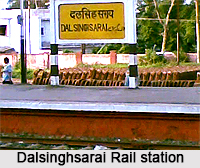 Dalsinghsarai is a town and a notified area in the Samastipur district in the state of Bihar in India. The river traversing the city is Balan. Dalsinghsarai is a sub-division of Samastipur district. The locality consists of rich alluvial soil that is noted for its fertility and for the excellence of its Rabi crops. The town is one of the biggest agricultural hubs for vegetable market in northern Bihar. This locality is also known for its tobacco production. This place is much known for its famous sweets "Raskadamba".
Dalsinghsarai is a town and a notified area in the Samastipur district in the state of Bihar in India. The river traversing the city is Balan. Dalsinghsarai is a sub-division of Samastipur district. The locality consists of rich alluvial soil that is noted for its fertility and for the excellence of its Rabi crops. The town is one of the biggest agricultural hubs for vegetable market in northern Bihar. This locality is also known for its tobacco production. This place is much known for its famous sweets "Raskadamba".
Demography of Dalsinghsarai
The 2001 census of India records that the city of Dalsinghsarai is populated by more than 50,000 people, out of which, 53% are males, 47% are females and 16% are children less than 6 years of age. The average literacy rate of 60% is inclusive of 69% male literacy and 51% female literacy. This becomes higher than the nationwide standard of 59.5%.
Transportation of Dalsinghsarai
Dalsinghsarai is well connected by road. This town is situated on National Highway 28, which links Barauni (Bihar) to the capital city of Uttar Pradesh, Lucknow, via Gorakhpur. The town has direct train link with Patna, Kolkata, Delhi, Ranchi and other places of importance. Patna Airport is the nearest airbase at Dalsinghsarai locating at a distance of 100 km.
This article is a stub. You can enrich by adding more information to it. Send your Write Up to content@indianetzone.com



















